The Cell
· The cell is a fundamental unit of life was first discovered by Rebert Hook in 1665 from slice of cork.
· An average diameter of a cell is about 2-120µm.
Cell theory
· The cell theory was proposed by Matthais Schleiden and Theodor Schwaan in 1839.
· All living thing are made up of cells.
· The cells are the smallest working unit of all living things.
Constituents of cell
· The cells are composed of different type substances are collectively known as protoplasm.
· The protoplasm is composed of;
o Water (70-80%)
o Carbohydrates
o Lipids
o Proteins
o Electrolytes: sodium, potassium, calcium, magnesium, phosphate, chloride, and bicarbonate.
Major structure of the cell
1. Cell membrane
2. Cytoplasm and cell organelles
3. Nucleus
Cell membrane
· The cell membrane also known as plasma membrane.
· This is thin pliable elastic outer most structure which envelops the cell.
· The plasma membrane of two layers of phospholipids (fatty substances) with protein and sugar molecules embedded in them.
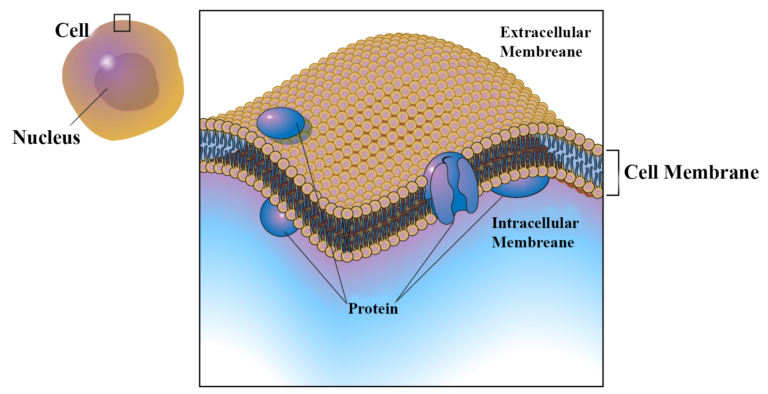
Function
· It is a selective barrier that regulates the flow of materials into and out of a cell.
· Protective
· Digestive: takes essential materials and excrete waste materials.
· Selective permeability;
o Non polar: oxygen, carbon dioxide, nitrogen, lipid, alcohol, hormone etc. is easily permeable.
o Polar: less penetrable – water, glucose, urea etc.
· Insulating
Cytoplasm
· The cytoplasm consists of all the cellular contents between the plasma.
· This compartment has two components: cytosol and organelles.
Cytosol
· The composed of water, solutes, suspended particles, lipid droplets and glycogen granules.
· In the cytoplasm the cytoskeletons are present which are composed of protein filaments.
Cytoskeleton
· The cytoskeleton is a network protein filament that extends throughout the cytosol.
· Three types of cytoskeleton structure are present;
o Microfilaments
o Intermediate filaments
o Microtubules
Microfilament
· The microfilaments are the thinnest elements of the cytoskeleton.
· They are composed of the protein actin and myosin.
· Microfilaments are responsible for muscle contraction, cell division, and locomotion. This mechanism occurs during the migration of embryonic cells during development, the invasion of tissue by WBC to fight infections, or migration of skin cells during wound healing.
· It also provides mechanical support for cell extension called Microvilli.

Intermediate filament
· Thicker than microfilament but thinner than microtubules.
· The are subjected to mechanical stress and helps to stabilize the position of the organelles.
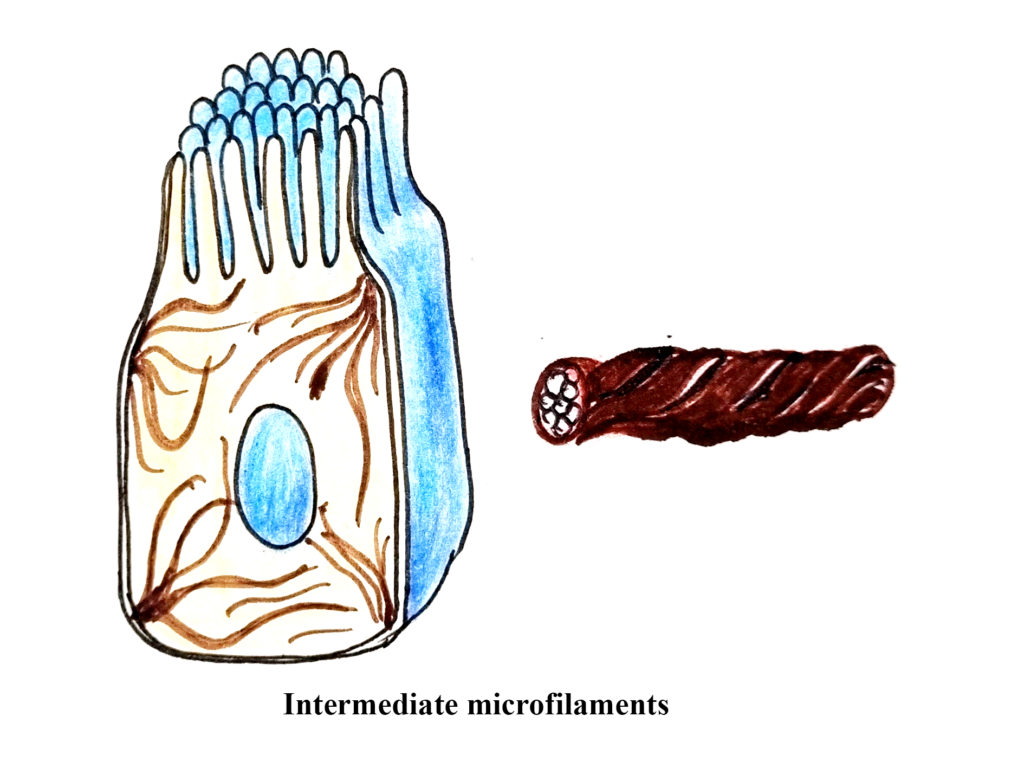
Microtubules
· It is largest, unbranched hollow tubes composed mainly of protein tubulin.
· The assembly of microtubules called centrosome.
· Microtubules helps to determine the cell shape.
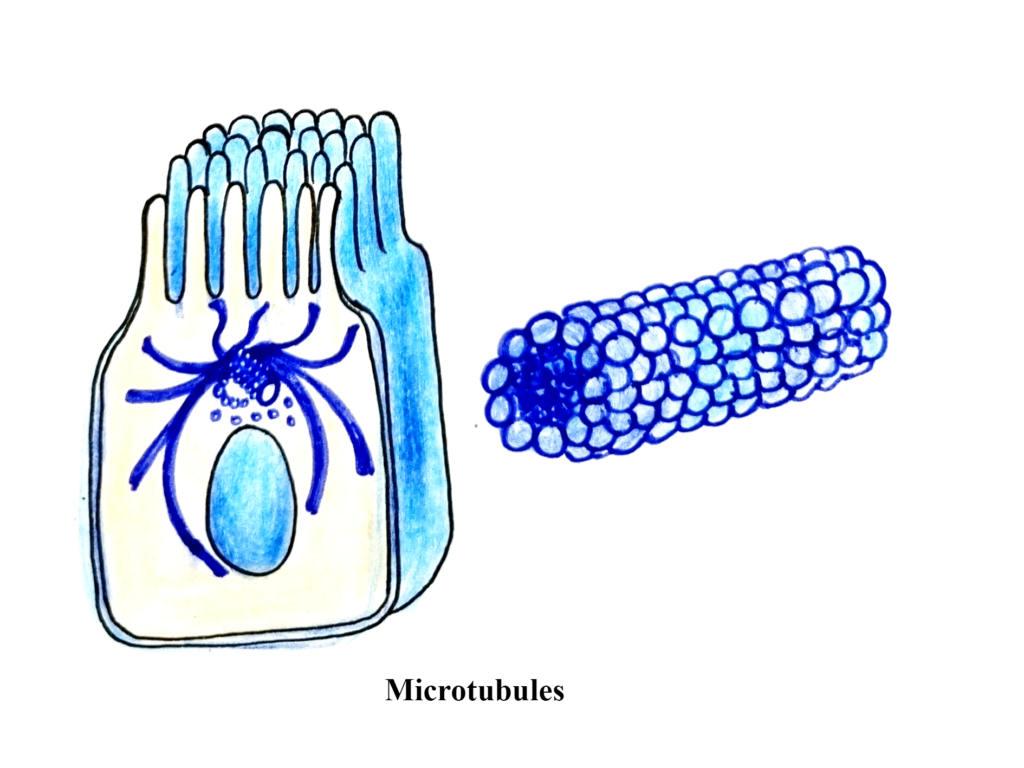
Cell organelles
Mitochondria
The mitochondria structurally composed of outer, matrix, and inner membrane.
Outer membrane
· It contains large integral membrane proteins called porins.
· The outer membrane allows molecules of 5000 Daltons or less
· It attached with enzymes concerned with biological oxidation.
Mitochondrial matrix
· The central fluid-filled cavity, enclosed by inner mitochondrial membrane called matrix.
· The matrix of the mitochondria contains enzymes responsible for TCA, and respiratory oxidation.
· The major pathways involve in oxidation of carbohydrates, lipids, and amino acid, and special biosynthesis pathways like urea and heme synthesis.
Inner membrane
· The inner membrane contains ATPase and other enzymes concerned with synthesis and metabolism of ATP.
· It contains electro transport chain (ETC).
· The inner mitochondrial membrane contains a series of folds called mitochondrial cristae.
· The elaborated folds of the cristae provide an enormous surface area of the chemical reaction that are the part of the aerobic phase of cellular respiration.
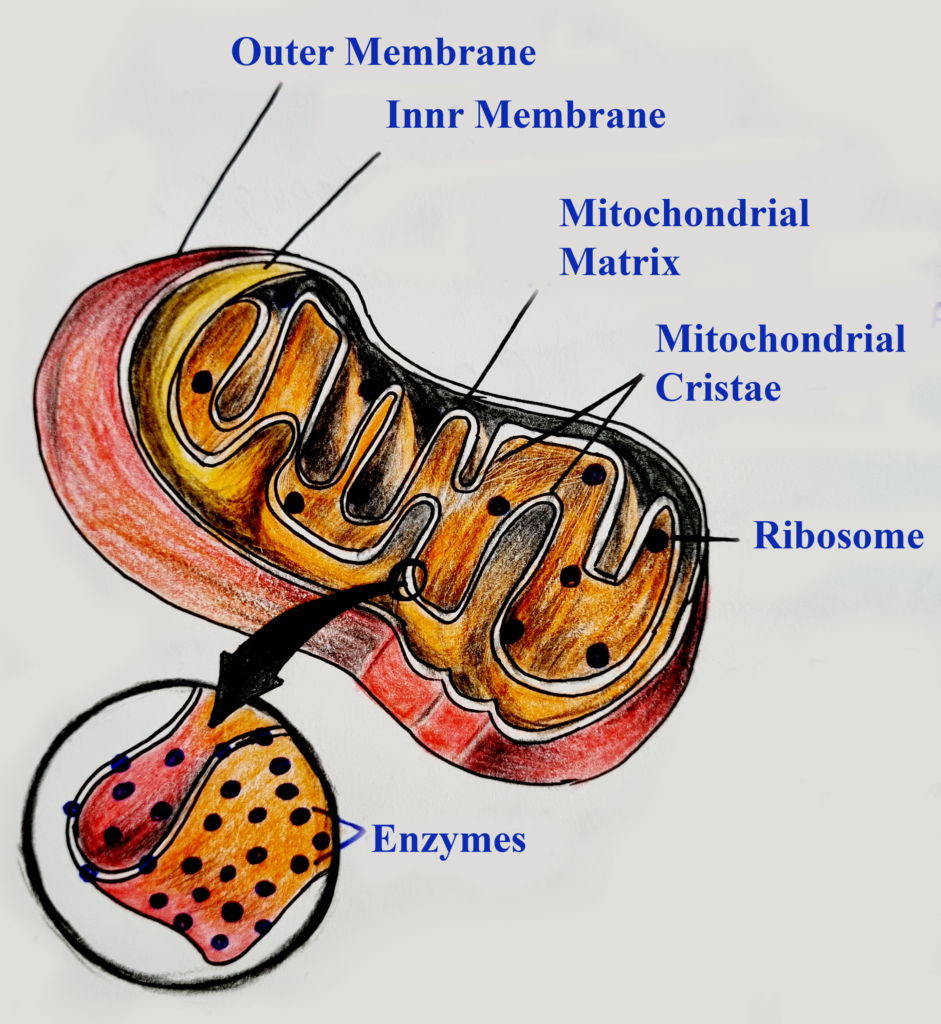
Function
· It is the power house of the cell
· To maintain concentration of Ca2+ ions with in the various compartments of the cells.
· Energy transduction through respiration.
· Responsible for thermogenesis (process of heat production in organism).
Endoplasmic Reticulum
· It is a network of membrane in the form of flattened sacs of tubules.
· The ER extends from the nuclear envelope to which it is connected and projects throughout the cytoplasm.
· Endoplasmic reticulum contains two distinct forms;
1. Rough ER
2. Smooth ER
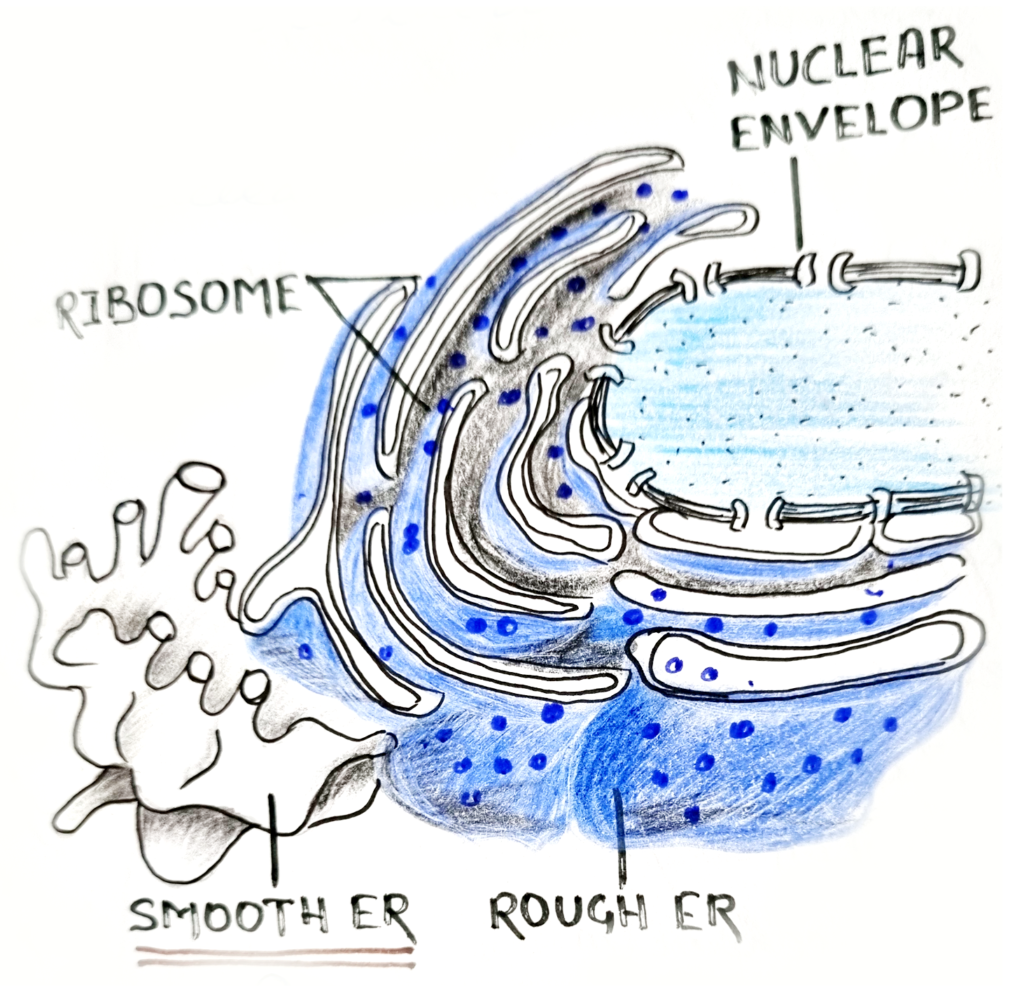
Rough Endoplasmic Reticulum | Smooth Endoplasmic Reticulum |
· It continues with the nuclear membrane are usually is folded into a series of flattened sacs. · The outer surface of ER contain ribosome. · Site of protein synthesis · Mainly present in protein forming cell | · Extends from the rough ER to form a network of membrane tubules. · Ribosome absent. · Site of synthesis of lipid and steroid hormones. · Mainly present in lipid forming cell. |
Function
· Synthesis of protein
· Unstaturation of fatty acid
Golgi complex
· The ribosomes are synthesized protein through ER and transported to another region of the cell.
· The first step includes in the transportation pathway is Golgi apparatus.
· The Golgi apparatus consist of stack of flattened membrane sacs called cisternae.
· It consists of 3-20 cisternae.
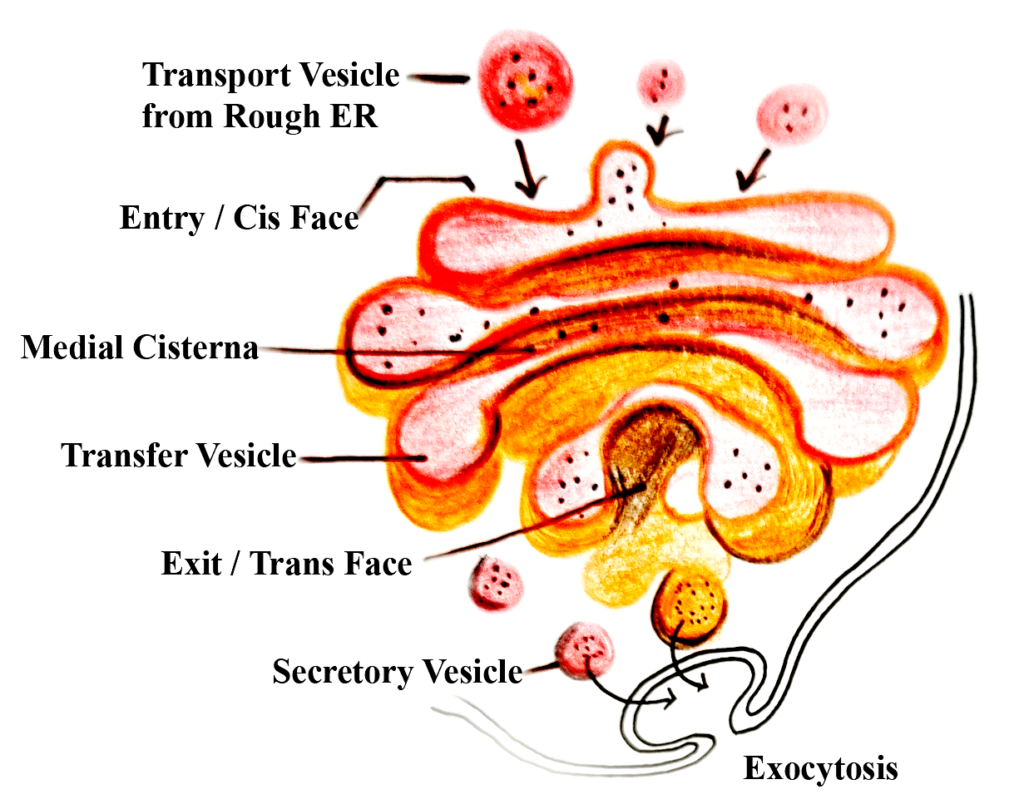
Protein moves from ER
↓
Golgi apparatus
↓
Entry face
↓
Medial
(Enzyme in the medial cisternae modifies protein to form glycoprotein, glycolipid, and lipoprotein)
↓
Exit face
↓
Membrane bound vesicle (secretory vesicle)
↓
Exocytosis
Function
· It concerned with the synthesis and secretion of enzymes and hormones in the cell.
· Golgi apparatus carries materials synthesized by the endoplasmic reticulum to different parts of the cell.
· the material is stored and packaged in the vesicles.
· It forms glycoproteins and complex sugar from simple sugar.
Lysosome
· Lyso-Dissolving, Somes-Bodies
· Lysosome are one types of secretory vesicle with membranous walls, which are formed by Golgi apparatus.
· It contains variety of enzyme that breaks down the larger molecules into smaller particle or recycled or extruded from the cell as waste materials.
· The lysosomal membrane also transports glycose, fatty acids, and amino acids into the cytosol.
Autophagy (Auto-Self, Phagy-eating)
· The lysosome replaced the old organelles by digest them and return the digested components to the cytosol for reuse. This process by which entire worn-out organelles are digested are called autophagy.
Autophagosome
· The organelles to be digested enclosed by membrane derived from ER to create a vesicle called autophagosome.
Autolysis
· The lysosomal enzyme may also destroy the entire cell called autolysis.

Peroxisome
· Another group of organelles similar in structure to lysosome, but smaller.
· Vesicle containing oxidase (oxidative enzyme) and catalyze (decomposed H2O2), new peroxisome but form preexisting one.
Function
· Oxidizes amino acid and fatty acid, detoxify harmful substance, such as H2O2 and associated free radicals.
Proteasome
· Tiny barrel-shaped structure that contain proteases (proteolytic enzyme).
Function
· Degraded damaged or faulty protein by cutting them into smaller peptides.

Hi…!! This is Smrutiranjan Dash, Assistant Professor of Pharmacology from Odisha, India. With a passion for teaching and a dedication to advancing the field of pharmacology, I am committed to sharing knowledge, fostering innovation, and inspiring future healthcare professionals.
About The Author
Hi...!! This is Smrutiranjan Dash, Assistant Professor of Pharmacology from Odisha, India. With a passion for teaching and a dedication to advancing the field of pharmacology, I am committed to sharing knowledge, fostering innovation, and inspiring future healthcare professionals.
